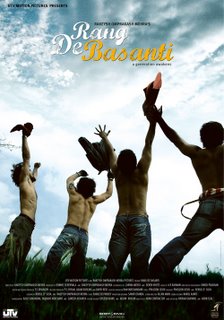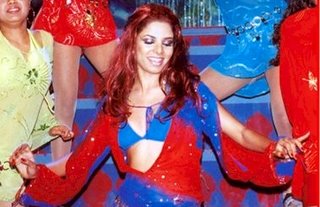"...don´t regard Bhandarkar as a filmmaker with great cinematic flair or vision. His style of storytelling is often dry and straightforward relying mainly on dialogues to get the point across. He does not trust the viewers to be intelligent enough to decide for themselves what each character is about. In "Page 3", Bhandarkar employs the tactic of staging short conversations between characters, such as the chauffeurs and the gatecrashers, to spell out how hypocritical and shallow the rich and famous are. These brief but regular scenes are tedious. Bhandarkar may as well have written it all in white chalk on the blackboard. He uses these same characters to preach about how spiritually empty most celebrities and politicians are.
These criticisms aside, the film´s strengths lie in the strongly etched characters and its refusal to consider any topic as taboo. Appropriately, Madhavi is a levelheaded character with a strong sense of ethics and principles. It is her sanity that makes so many other people, within the stories, seem so
 absurd and so cruel. The diverse characters lend a rich touch to the story. There are three gay male characters and the fact that they are all totally different from each other shows the effort gone into staying away from senseless stereotyping. The girl buddies (Madhavi, Pearl and Gayatri) are also very different from each other bringing in a nice mixture of humour and emotional bonding. To explore in to the depths of such characters, Bhandarkar is not afraid of delving into the darker matters. Revelations of the casting couch, gay sexual favours and child abuse leaves one resoundingly shocked precisely because they are caused by characters that you don´t expect such depravity from. As the closing credits roll silently, the audience is left to reflect on the distressing developments that have taken place.
absurd and so cruel. The diverse characters lend a rich touch to the story. There are three gay male characters and the fact that they are all totally different from each other shows the effort gone into staying away from senseless stereotyping. The girl buddies (Madhavi, Pearl and Gayatri) are also very different from each other bringing in a nice mixture of humour and emotional bonding. To explore in to the depths of such characters, Bhandarkar is not afraid of delving into the darker matters. Revelations of the casting couch, gay sexual favours and child abuse leaves one resoundingly shocked precisely because they are caused by characters that you don´t expect such depravity from. As the closing credits roll silently, the audience is left to reflect on the distressing developments that have taken place.Konkona Sen Sharma is an intense performer and she proves this once again with "Page 3". As the film grinds its way to the climax, Sharma brings out the heart-wrenching agony of her character. She excels in the final scene as she wanders through the crowds looking at the rich and famous as if they are nothing but empty skeletons. The other actresses who also leave an impact are Sandhya Mridul and Tara Sharma. Though this is not quite a breakthrough performance, Tara Sharma´s surprising change of look and attitude in the final scene suggest a sensitive actress whose talent has not been seriously tapped into by other directors. Sandhya Mridul must be very familiar by now with the role of a strong-headed single female and she once again tucks into this character with relish. The remaining actors (and there are many to mention!) such as Boman Irani, Atul Kulkarni, Upendra Limaye and Bikram Saluja lend solid support. Jai Kalra is okay as Madhavi’s love interest, Tarun.
"Page 3" is perhaps the first Madhur Bhandarkar film with a seriously strong musical soundtrack. Shamir Tandon has come up with a varied selection of tunes that range from rock to bhangra to sweet melody. Most of them are used in the background except for Lata Mangeshkar´s "Kitne Ajeeb Rishte Hain Yahan Ke". This song, one of the best moments in the movie, shows new relationships and friendships developing among the characters.
http://www.planetbollywood.com/Film/Page3/
Reviewed by: Shahid Khan Reviewer's Rating: 7 out of 10
My comments: I actually agree with the Review to some extent, i think that everyone should watch it, even thought is very gritty and explicit it infact shows you how life is like. I wasnt suprised that most people in India didnt like this film as it is a new type of genre in a way ans as they are not used to realism they do not find it entertaining. We are forced to see the film through the perpective of a niave character. the director himself suggested that the audience are infact oblivious to the corrupt system therefore by using explicit dialogue and imagery dictates the society they live in.





